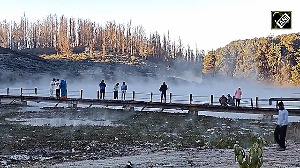 Just as the United States east coast is limping back to recovery from the destruction caused by Sandy, another strong coastal storm threatens to hit the region this week and could result in high winds, flooding and power outages, further exacerbating the damage caused by the megastorm.
Just as the United States east coast is limping back to recovery from the destruction caused by Sandy, another strong coastal storm threatens to hit the region this week and could result in high winds, flooding and power outages, further exacerbating the damage caused by the megastorm.Though there is still uncertainty over its exact course and timing, the new coastal storm could bring windy conditions with high winds in the range of 50 miles per hour.
"Unfortunately a strong coastal storm appears likely for the latter half of the coming week. While there is still some uncertainty regarding the precise track and timing of the coastal storm in the northeast, substantial impacts are expected from this storm, many of which will be greater due to the damage caused by Sandy," the National Weather Service said.
The high winds could knock down trees already weakened from Sandy and the greatest threat would be near the coast.
The agency said while the coastal storm would be "nowhere near as bad as Sandy", the combination of storm surge and wave action could cause minor to moderate flooding and additional beach erosion along the mid Atlantic and New England coast.
For New York City and the New England region, the high tides during the middle of next week threaten to cause flooding. The storm could also bring in wet snow in the interior sections from Virginia to New England.
The weight of accumulating wet snow could bring down tree branches already weakened from Sandy, especially where leaves might still be on the trees.
Other potential impacts of the storm include localised flooding from heavy rain and wet snow causing power outages and making travel conditions "hazardous".
The US east coast is still reeling from the effects of Sandy, which turned out to be the most devastating storm to hit the eastern seaboard and caused unprecedented damage in New Jersey and New York.
A week after the storm made landfall, millions are still without power, the mass transport system is yet to be fully restored and shortage of gas is exacerbating the problems of residents who are now also grappling with cold weather conditions.
The death toll in the US due to the storm reached 110, in addition to two killed in Canada and 67 in the Caribbean. The US Energy Information Administration said an estimated 27 per cent of gas stations in the New York metropolitan area, which includes parts of Connecticut, New Jersey and New York state, do not have gasoline available for sale.
This is down from roughly 38 per cent on Saturday and 67 per cent on Friday, when significant gas shortages led to long lines at stations.
The severe gas shortage prompted New Jersey to begin rationing gasoline in 12 counties throughout New Jersey. Under the rationing rules, drivers whose license plates end in an odd number may only buy gas on odd-numbered days of the month and those with even-numbered plates will be eligible to buy gas on even-numbered days. \
According to data from power utility companies, more than 1.5 million customers were still without power with over 900,000 of those outages in New Jersey and about half a million in New York.
The US Energy Information Administration said an estimated 27 per cent of gas stations in the New York metropolitan area, which includes parts of Connecticut, New Jersey and New York state, do not have gasoline available for sale.
This is down from roughly 38 per cent on Saturday and 67 per cent on Friday, when significant gas shortages led to long lines at stations.
The severe gas shortage prompted New Jersey to begin rationing gasoline in 12 counties throughout New Jersey.
Under the rationing rules, drivers whose license plates end in an odd number may only buy gas on odd-numbered days of the month and those with even-numbered plates will be eligible to buy gas on even-numbered days.
Image: Waves crash against the demolished section of a boardwalk in the north end of the city in the aftermath of Hurricane Sandy's landfall in Atlantic City, New Jersey | Photograph: Tom Mihalek/Reuters











 © 2025 Rediff.com -
© 2025 Rediff.com -